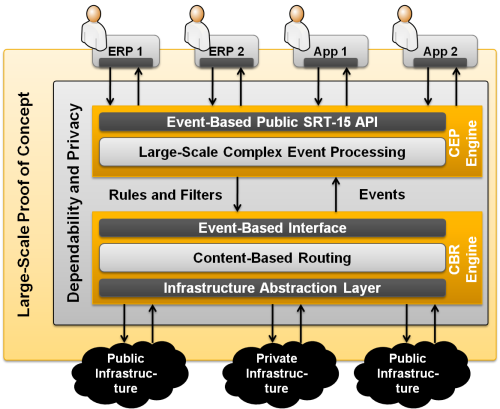SRT-15 Overview
The goal of the SRT-15 research project is to build a scalable platform for connecting business applications and services by enabling the discovery and integration of dynamic enterprise services on the Internet. SRT-15 will allow for dependable and scalable cloud-based processing of data coming to and from a variety of heterogeneous enterprise services spread across multiple distributed locations. In order to be able to embrace the change in the enterprise information processing landscape, SRT-15 relies on technologies that support rapid change: cloud computing, content-based routing, and complex event processing.
Not only does SRT-15 embrace change, it also controls it. Privacy and dependability have been recently identified as main challenges associated with the on-demand model. By design, SRT-15 will support extreme robustness and will preserve the privacy of data which is processed in the public and private clouds SRT-15 is deployed upon. This will enable SRT-15 to maintain control over the dependability and privacy of the enterprise data despite failures and breaches of the underlying infrastructure.
SRT-15 Scales Across Public and Private Clouds
Cloud computing gives the possibility to elastically scale the computing infrastructure to changing business needs. Cloud computing in the context of SRT-15 is all about moving services, computation and data off-site to an internal or external, service infrastructure - for scalability as well as cost and business advantage. SRT-15 makes data available in the cloud, and allows for easy and ubiquitous data access. SRT-15 enables collaboration, integration, and analysis on a shared common platform. SRT-15 will build on top of the Infrastructure as a Service and will expose Platform as a Service APIs/services for use and creation of new services and applications.

SRT-15 Uses Content to Route Information
The components of service-oriented architectures must be designed so as to be autonomous, composable, and responsive to input, exceptions, and changes. Event-driven design offers the flexibility to address these issues and reflects the real world’s event-driven nature. Therefore, the goal of the SRT-15 platform is to avoid tightly coupled dependencies by becoming event-driven.
The event-driven approach to the construction of the SRT-15 platform will provide loose coupling of components. Whilst different approaches to the construction of loosely coupled platforms exist, SRT-15 will decouple its services using the content-based routing layer. The content-based routing layer will provide an event-based abstraction which allows SRT-15 to run on different trusted and untrusted clouds.
SRT-15 Provides Flexible and Timely Service Interaction
Contemporary companies face a flood of data originating in different, distributed applications and services, ranging from simple RFID events to complex business and financial events. The flexible and timely interaction of different services operating on SRT-15 platform implies that SRT-15 needs to be able to process and analyze high volumes of data in real-time. Such challenging real-time requirements for acting on urgent events cannot be met by contemporary, general event analysis software, such as traditional database systems.
SRT-15 will use Complex Event Processing (CEP) to connect different services using the cloud infrastructure. CEP will filter and aggregate events between services publishing information (publishers) and services receiving information (subscribers). The goal of SRT-15 is to use the distributed CEP technology in conjunction with content-based routing to achieve the real-time service interaction. SRT-15 will use the CEP to close the gap between the constantly increasing amount of information produced and stored by different applications and users and the relatively stable cost for the information transmission.
SRT-15 Processes Data in Distributed and Parallel Fashion
SRT-15 will ensure extreme scalability and flexibility of CEP by parallelizing the information processing across different nodes and processor cores. SRT-15 will use the content-based routing to distribute the parts of the CEP algorithms across nodes and asynchronous processing of subtasks to distribute the processing among multiple cores. The partitioning and parallelization process will be continuously adaptive as both data streams and queries might change over time. Thus, SRT-15 will autonomically adjust its data-access mechanisms in response to the operational context (bandwidth cost, bandwidth latency, legal data location requirements) for the applications and services using the SRT-15 platform.
SRT-15 is Dependable and Protects Data Privacy
An increasing number of components of large-scale applications and services, as well as an increasing amount of data being processed by such systems, leads to a higher probability of failures. Moreover, it is expected that in the future, the decreasing feature size of hardware will lead to less reliable systems.
The traditional approaches toward coping with such issues are expensive and usually introduce unacceptable overheads. Hence, the approach of SRT-15 is to introduce cost-efficient dependability for ultra-scalable systems. SRT-15 will use software techniques in order to ensure end-to-end data confidentiality, integrity, and availability preventing the propagation of incorrect data. Moreover, SRT-15 will be able to tolerate failures beyond the crash of the processing nodes.
The SRT-15 platform will be designed in such a way as to reduce the data privacy risks resulting from the use of the trusted and untrusted clouds. It will also be designed with focus on the privacy of data from the outset. Specifically, SRT-15 will facilitate a content-based routing of encrypted messages without revealing their content to nodes other than source and destination.


